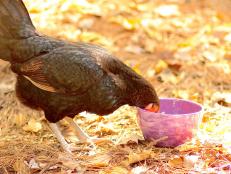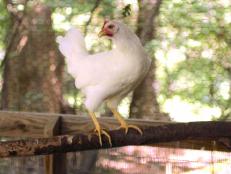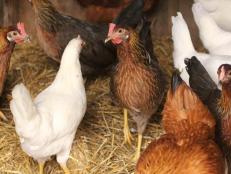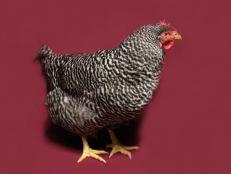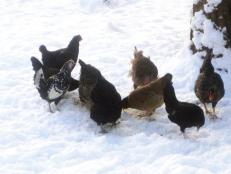Can Chickens Fly?
What to do when a chicken flies the coop.


My chickens free range regularly in the yard. Although a solid eight foot fence surrounds the property, the birds will occasionally make their way into neighboring yards. Tending to the garden one afternoon, I could hear kids on the other side of the fence discussing a leghorn that had apparently wandered over to visit. Suddenly, a dog began angrily barking.
In an instant, there was a flapping of wings as the startled hen soared over the tall fence back into my yard where it landed gracefully (at least by chicken standards) and resumed grazing.
“Oh, snap!” a young voice cried from the other side of the fence. “I didn’t know chickens could fly!”
Many think of chickens as earthbound birds, but those new to backyard chicken keeping may be surprised to find a pullet has mysteriously escaped the pen or free rangers are found perched on high fences or in trees. One intrepid hen in my flock will even occasionally find its way onto the roof of the house to forage for insects in fallen leaves.
Snap, indeed. Chickens can fly (just not very far).
While there was never a time when chickens filled the skies, their ancestors were a bit more adept than current breeds. Domesticated for meat and egg production, modern chickens have developed a smaller wing-to-weight ratio, feet better suited to the ground than branches and beaks built for ground foraging. Still, when danger lurks or better foraging can be found on the other side of a fence, a determined chicken will take flight.
Depending on the breed, chickens will reach heights of about 10 feet and can span distances of just forty or fifty feet. The longest recorded flight of a modern chicken lasted 13 seconds for a distance of just over three hundred feet. It may not sound like much, but for those wrangling a flock of backyard chickens, fifty feet may be all the distance it takes to encounter unhappy neighbors, angry dogs or busy roads.
What should be done when a chicken takes flight?
Nothing. Chickens instinctively return to the coop at dusk. If they remain on your property and out of danger, daytime roosting in tree branches or on structures may be harmless behavior.
Keep them fed. Chickens occasionally fly over fences in search of food. Make sure food and water dispensers are kept full and easily accessible.
Provide higher perches. In coops where roosts are low to the ground, birds occasionally seek out higher perches on which to roost overnight, leaving them prone to nocturnal predators. Provide higher perches within the coop and refrain from free ranging for a few days to allow them time to adjust to new roosting habits.
Clip wings. Trimming a couple of inches from the tips of the largest primary feathers on one wing will inhibit a chicken’s ability to fly even short distances. Although this is an effective solution, bear in mind that the ability to take limited flight is a primary defense for a chicken when encountering predators like foxes, dogs or cats. Clipping should only be employed when necessary for the safety of the flock.






